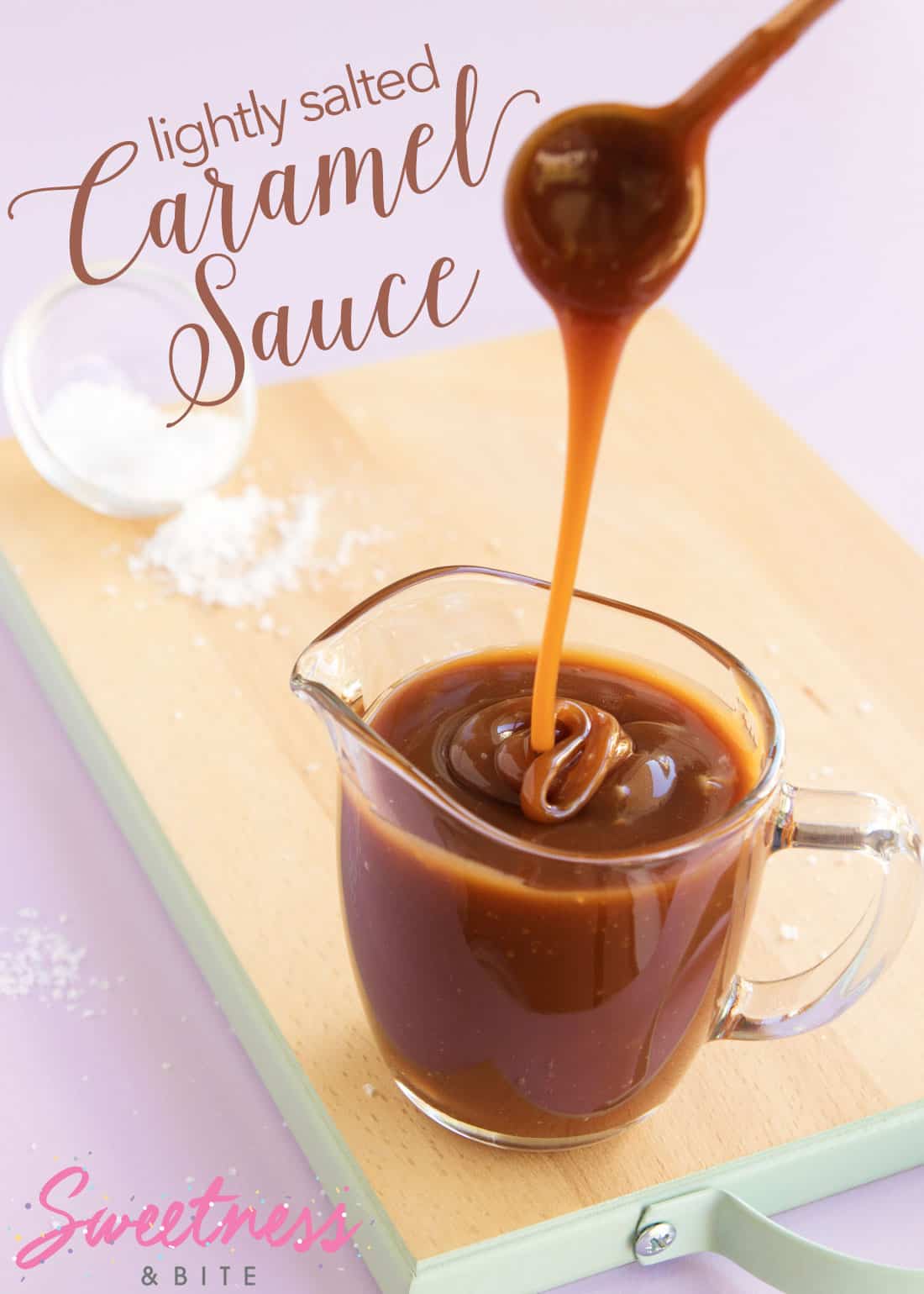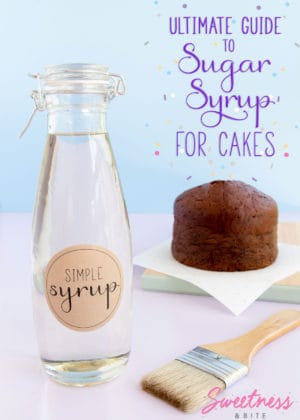Lightly Salted Caramel Sauce
This post may contain affiliate links to products I recommend. I receive a small commission at no cost to you if you make a purchase using my link.
A rich, dark homemade caramel sauce recipe with just the right amount of salt.
Not too salty and not too sweet – if you asked Goldilocks, she’d probably reckon it was just right.

Remember a couple of months back when I told you I had found “The One”? If you missed it, I’m not talking about a person (if my “One” guy is out there, he’s so well hidden he must be wearing camouflage) but rather I found the one lemon curd recipe for me. Which led me to realise there’s another soulmate recipe that I hadn’t shared yet. The One Caramel Sauce. So here it is! Lightly Salted Caramel Sauce.
Why is it a ‘lightly salted’ caramel sauce recipe? I think
And let’s face it, ever since ‘salted caramel’ became “A Thing”, people have really been overdoing the salt. The salt is there to enhance the flavour and cut through some of the sweetness, not make you feel like you’ve been licking a piece of caramel-drizzled driftwood at the beach.
So while this recipe does contain salt, it’s not hit-you-in-the-face salty.
Like baby bear’s porridge, it’s just right.
Let’s face it, ever since ‘salted caramel’ became “A Thing”, people have really been overdoing the salt. The salt is there to enhance the flavour and cut through some of the sweetness, not make you feel like you’ve been licking a piece of caramel-drizzled driftwood at the beach.
So while this recipe does contain salt, it’s not hit-you-in-the-face salty.
Like baby bear’s porridge, it’s just right.

Ways to Use Caramel Sauce
Even if you don’t want to swim in it, you can use this sauce in so many other ways.
- It’s thick enough and sets firmly enough that you can use it to make a drip on a caramel cake.
- You can use it to flavour buttercream as a cake filling – it’s absolutely brilliant in Swiss meringue buttercream.
- Use it in all your favourite desserts. Like chocolate caramel cheesecakes… just sayin’.
- Stir a spoonful into your morning (or afternoon) coffee for a little extra pick-me-up.

Caramel Sauce Ingredients
- Cream – The cream you need for this recipe is known by different names in different countries. Here in NZ it’s usually called standard cream or whipping cream, elsewhere it may also be known as single cream or full cream. Heavy cream will also work.
- Sugar – I prefer to use caster sugar to make caramel sauce, as it dissolves more easily, but regular granulated sugar will work here, too.
- Corn syrup or liquid glucose – You can use whichever of these you have. These ingredients help to stop the sugar recrystallising and making the sauce grainy.
- Butter – Unsalted butter works best here, so you can control the amount of salt you add. If you only have salted butter, then use that, but add less salt.
- Salt – I like to use flaky sea salt here, but any salt will do. Because different types of salt have different volumes, if you’re using a finer salt, you’ll need to start with a smaller amount and adjust from there.
How to Make Caramel Sauce
I know a lot of people are scared of making caramel from scratch. To be honest, while the recipe isn’t complicated, you do need to concentrate and know what to look out for as the caramel cooks.
If you happen to have a candy thermometer then it will take the guessing out of whether your caramel is cooked enough, but you can absolutely make it without one. If you have eyes and a nose, you can tell when the caramel is done. At some point, I’ll try and add some step-by-step photos to this post, but right now the kitchen situation is such that I really can’t take photos of anything. But once the kitchen gets redone I’ll get onto it.
Basically, there are a few stages you can expect when making caramel. Obviously, you’ll start out with the sugar and water in a pan so it’ll be, well, wet sugar in a pan. You’ll start stirring and heating it, and the sugar will start to dissolve. At this point, you’ll need to use a wet pastry brush to brush down the sides of the pan, to stop a rogue sugar crystal from ruining your batch of caramel. Trust me, those rogue crystals are mean and nasty. Brush ‘em down and melt ‘em.
Once you crank up the heat, the syrup will begin to boil and the last of the sugar crystals will melt. The bubbles will be thin and they will rise and pop quickly on the surface. As the syrup cooks and the water evaporates, the bubbles will become thicker and a little slower to expand and pop.
Then the caramel will begin to colour. Usually, this starts at the edges, you can gently swirl the pan to mix it up. This part is the trickiest part of the recipe, judging when the caramel is ready to take off the heat and add the cream. Basically, you want it to be a deep amber colour, and it should smell deeply caramel-ly. It’s gettin’ deep, guys. If you’re nervous, it’s better to take the caramel off the heat earlier rather than later. You can deepen the colour and flavour a bit more when you’ve added the cream and bring the sauce back to a boil, but you can’t save burnt caramel. I’m not going to lie – for me, it took burning a pot of caramel for me to recognise the signs of it being almost done.
Next, well, this bit ain’t so hard so I’ll leave it for the recipe. But I will give you some troubleshooting tips for some of the most common problems with caramel sauce:
Troubleshooting
Caramel is too thick: add some more warm cream, a tablespoon at a time until the correct consistency is achieved.
Caramel is too thin: If the sauce is also very light in colour then you probably didn’t cook the caramel for long enough. Put it back in the pan over medium heat and boil gently (stirring constantly) until it thickens and darkens more in colour.
Caramel doesn’t have enough flavour/is too pale: The caramel hasn’t cooked enough, either at the caramel stage or after adding the cream. Heat it again as described above, to help deepen the colour and flavour.
It’s burnt! *sad face*: I’d love to have better news for you, but unless you have a time travel machine and can go back to before you burnt it, then you’re going to have to start over. To get the burned caramel off the pot, you can put some water in it and place it back on the heat to melt the sugar. Rubbing with baking soda also works.

Lightly Salted Caramel Sauce
Ingredients
- 250 ml whipping cream regular cream
- 400 g sugar
- 125 ml water
- 2 tablespoons corn syrup or liquid glucose
- 50 g unsalted butter cut into small cubes
- 2 teaspoons flaky sea salt more or less, to suit your taste
Instructions
- Measure the cream into a microwave safe jug, and microwave until warm (around 30 sec – 1 minute, depending on your microwave power). The temperature isn’t too important, but warming the cream will help it splatter less when you add it to the caramel. Set aside.
- Place the sugar, water and corn syrup or glucose in a medium saucepan. Stir gently until all the sugar is moistened. Place over a medium-low heat and stir for a minute or so, without letting it boil, until the sugar starts to dissolve. Use a damp pastry brush to brush down any remaining sugar crystals on the sides of the pan.
- Increase the heat to high and bring the syrup to a boil, and boil until it reaches a deep amber colour. It will be about 170°C (338°F) on a sugar thermometer. If you don’t have a thermometer, pay attention to the stages the syrup goes through. After it comes to the boil, the last of the sugar crystals will melt. The bubbles will be thin and rise and pop quickly on the surface. As the syrup cooks and the water evaporates, the bubbles will become thicker and a little slower to pop. Once it reaches the deep amber colour, it’s ready.
- Immediately remove the caramel from the heat, and carefully pour in the cream. It will splatter, so be careful! Stir with a wooden spoon or heatproof spatula to combine. Don’t panic if there are any hard bits of set caramel. Place the pan back over medium heat, and bring it back to a boil, stirring constantly, until the sauce reaches 115°C (240°F). If not using a thermometer, just boil the sauce for several minutes, until it darkens a little more in colour and thickens slightly.
- Remove from the heat and stir in the butter and most of the salt. If the butter isn’t combining well, switch to stirring with a whisk. Once it’s all combined, remove a spoonful of the sauce, let it cool a bit (it’s hot as hell, don’t burn your tongue!) and taste it to check the salt level. Add more salt if necessary.
- Leave the sauce to cool before using. It will thicken considerably as it cools.
- Store the sauce in a sealed container in the refrigerator for several weeks. Reheat gently before using.
Notes
Recommended Equipment
Nutritional Disclaimer: Any nutritional information provided is a computer generated estimate and is intended as a guide only.
I’ll be back soon with a recipe so you can use your lightly salted caramel sauce to make a so-delicious-you-won’t-believe-how-easy-it-is dessert.
~Natalie
xx
You May Also Like…




